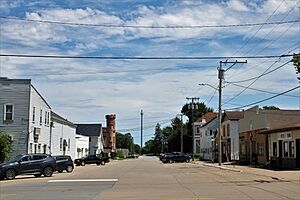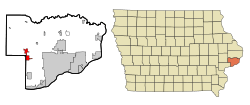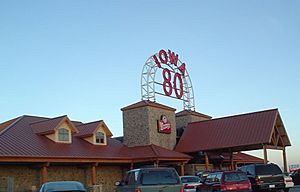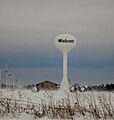Walcott, Iowa facts for kids
Quick facts for kids
Walcott, Iowa
|
|
|---|---|

Buildings along E. Bryant Street
|
|
| Motto(s):
"Heart & Hands Working Together"
|
|

Location of Walcott, Iowa
|
|
| Country | |
| State | |
| Counties | Scott, Muscatine |
| Area | |
| • City | 3.14 sq mi (8.12 km2) |
| • Land | 3.11 sq mi (8.06 km2) |
| • Water | 0.02 sq mi (0.06 km2) |
| Elevation | 732 ft (223 m) |
| Population
(2020)
|
|
| • City | 1,551 |
| • Density | 498.55/sq mi (192.47/km2) |
| • Metro | 382,630 (135th) |
| Time zone | UTC-6 (Central (CST)) |
| • Summer (DST) | UTC-5 (CDT) |
| ZIP code |
52773
|
| Area code(s) | 563 |
| FIPS code | 19-81705 |
| GNIS feature ID | 0462603 |
Walcott is a city in the state of Iowa, USA. It is located in both Muscatine and Scott counties. In 2020, about 1,551 people lived there.
Walcott is famous for being home to the Iowa 80 truck stop. This huge complex of restaurants, motels, and truck stops is known as the world's largest! It's located right off Interstate 80. Most of Walcott is part of the larger Metropolitan Statistical Area, which includes cities like Davenport and Moline.
Contents
The Story of Walcott: History of the City
Walcott officially became a city on July 10, 1894. But its story began much earlier.
How Walcott Got Its Name
The area where Walcott now stands was first mapped out in 1854. A year later, in 1855, the first passenger train route west of the Mississippi River started running through the area. This train service helped the small town grow.
A man named William Walcott was a director for the Chicago and Rock Island Railroad. In 1855, he gave $500 to help build a school. He had one condition: the new town near the railroad tracks had to be named after him! That's how Walcott got its name.
Early People and Settlers
Long before Walcott was a town, the land was open prairie. The Kaskaskia people lived there. Later, the Meskwaki tribe, a group from the Canadian Iroquois, moved into the area.
In 1857, much of the land in Walcott was sold for very low prices, sometimes as little as 75 cents an acre. This made it possible for many German and Scotch-Irish immigrants to move to the area. Many Scotch-Irish people worked for the railroad. They settled on farms south and west of town. Around 1871, many of them moved further west. Most German settlers came from Schleswig-Holstein in northern Germany. By 1910, German immigrants or their families owned almost 90 percent of the farmland in Scott County.
Becoming an Official City
On June 5, 1894, people in Walcott asked the court to make their town an official city. At that time, 354 people lived there. An election was held on July 7, 1894. Out of 81 votes, 54 people voted to make Walcott a city. The court approved the results on July 14, 1894.
Making Life Better: Water and Fire Services
Walcott was one of the first communities in rural Scott County to build a water system and a water tower. This was completed in 1897. It gave people affordable drinking water and helped protect against fires. In 1914, the town built its first sewage system.
The people of Walcott also created an organized fire department in 1897. Back then, it was a small group of volunteer firefighters with two hand-pulled hose carts. In 1931, the town built a fire station and city hall. Today, the same building still houses the Fire Department and City Hall.
Walcott's Banks and Growth
The Walcott Savings Bank started in 1894. Another bank, Farmers Savings Bank, opened in 1904. In 1911, Walcott was called the "richest town in the US" for its size. This was because of how much money its banks held compared to its population of 300 people. During the Great Depression in 1931, the two banks joined together to form Walcott Trust and Savings Bank.
The town of Walcott grew over the years. In 1962, it expanded to include Highway 6. More land was added in 1973, including the area around Interstate 80. In the early 1990s, even more land near Interstate 80 was added. This expansion, especially around the highway, brought many new businesses to Walcott. This includes the world's largest truck stop, Iowa 80 Truck Stop.
Sister City Connection
In 1997, Walcott became a "sister city" with Bredenbek, a town in Germany. This means they have a special friendship and connection.
Where is Walcott? Geography of the City
Walcott is located at coordinates 41°35′25″N 90°46′23″W / 41.59028°N 90.77306°W.
The city covers a total area of about 3.49 square miles (9.04 square kilometers). Most of this area, about 3.47 square miles (8.99 square kilometers), is land. A small part, about 0.02 square miles (0.05 square kilometers), is water.
Who Lives in Walcott? Demographics
| Historical populations | ||
|---|---|---|
| Year | Pop. | ±% |
| 1900 | 362 | — |
| 1910 | 416 | +14.9% |
| 1920 | 384 | −7.7% |
| 1930 | 398 | +3.6% |
| 1940 | 440 | +10.6% |
| 1950 | 480 | +9.1% |
| 1960 | 664 | +38.3% |
| 1970 | 989 | +48.9% |
| 1980 | 1,425 | +44.1% |
| 1990 | 1,356 | −4.8% |
| 2000 | 1,528 | +12.7% |
| 2010 | 1,629 | +6.6% |
| 2020 | 1,551 | −4.8% |
| Source: and Iowa Data Center Source: |
||
Walcott's Population in 2020
In 2020, there were 1,551 people living in Walcott. There were 664 households and 417 families. The city had about 498.5 people per square mile.
Most of the people in Walcott were White (94.2%). A small percentage were Black or African American (0.5%), Native American (0.1%), or Asian (0.1%). About 1.0% were from other races, and 4.2% were from two or more races. People of Hispanic or Latino background made up 2.8% of the population.
The average age in Walcott was 43.2 years old. About 25.2% of residents were under 20 years old. About 21.7% were 65 years old or older. The population was almost evenly split between males (47.8%) and females (52.2%).
Walcott's Population in 2010
In 2010, Walcott had 1,629 people living in the city. There were 694 households and 456 families. The population density was about 469.5 people per square mile.
Most residents were White (97.5%). About 2.5% of the population was Hispanic or Latino.
The average age in the city was 40.3 years. About 24.9% of residents were under 18 years old. About 15.8% were 65 years old or older. The population was 49.5% male and 50.5% female.
Learning in Walcott: Education
Most of Walcott is served by the Davenport Community School District. Students in Walcott typically attend Walcott Elementary School, Walcott Intermediate School, and Davenport West High School.
Sister City: Walcott's International Friendship
 Bredenbek in Germany
Bredenbek in Germany
Images for kids
See also
 In Spanish: Walcott (Iowa) para niños
In Spanish: Walcott (Iowa) para niños




